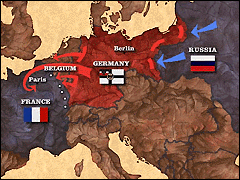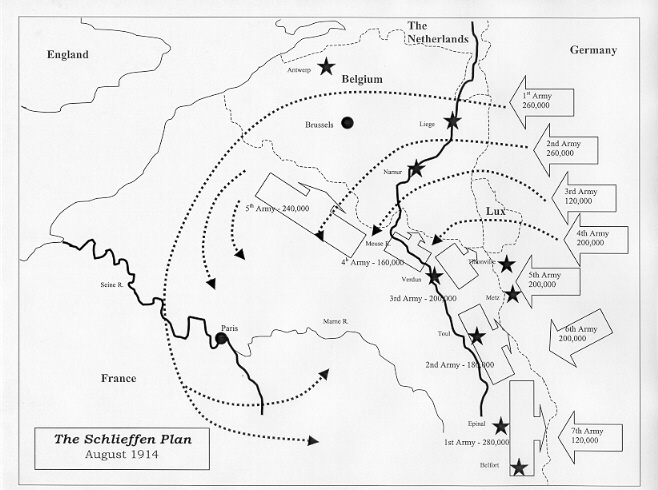
The
Western
Front
Museum
Last updated:
Neutral by choice?
Long before the war started in 1914 it was clear which country would support the other. Germany and Austria-Hungary had already an agreement dating back since 1879, Turkey joined up in 1914, followed by Bulgaria in 1915. Opposite these belligerent countries stood England and France (Treaty of 1904), Russia (1907), Japan (1914), Italy (1915), Romania (1916), Greece (1917) and U.S.A. (1917).
The Schlieffen Plan:
Every conflict has its neutral powers and the First World War was no exception. Holland was one of them, and the fact that it would stay Neutral had already been established long before the First World War started. Not being connected by treaties of some kind to any of the surrounding countries
had to amphasize this status. Neutral all the way. Even during the peace-conference of 1907 Holland made sure that every nation present was aware of her neutrality and that it would be heavily defended if it ever came to that. Although special Military Laws introduced
in 1912 had to make sure that more money was given to the expansion of Holland's national defense system it was at the outbreak of the war by no mean up to standard.
It wasn't however out of free choice that Holland kept her neutrality in 1914 although most history-books will let you believe otherwise. Surprisingly enough it had Germany to thank for that. The idea behind the so-called Schlieffen Plan, development by one of Germany's most devoted and
unscrupulous Chief of General Staff Count von Schlieffen, was to invade France in one crushing blow, based on the fact that France did not build any of their defense systems along the Belgium border thus leaving the backdoor to France width open. If this happened, Britain and Russia would be unwilling to carry on fighting.

Von Schlieffen's original plan
Von Schlieffen calculated that it would take Russia at least six weeks to organize its large Army for an attack on Germany. Schlieffen's plan involved using 90% of Germany's armed forces to attack France. When Helmuth von Moltke replaced Von Schlieffen as German Army Chief of Staff in 1906, he modified the plan by proposing that Holland was not invaded (as a result of this the main port of Rotterdam remained open for business which was also beneficial to Germany). The main route of the attacking force would now be through the flat plains of Flanders.

Schlieffen's Plan revised by H. von Moltke
Also Belgium claimed to be neutral but learned very quickly that being neutral and defenseless is merely an invitation to any unscrupulous aggressor. A letter was sent by Prins Albert of Belgium to Wilhelm II with the request to spare his country from invading. In answer the Kaiser of Germany sent out an ultimatum to the King of Belgium on the 2nd. August 1914 that stated that Belgium could stay a free country if they let German soldiers march through Belgium. The answer was negativ, and as a result of this German soldiers fought their way into Belgium.

Schlieffen Plan- August 1914
Countries only manage to preserve their neutrality because they were not in the path of the aggressor or whose neutrality gives an opportunity for trading, spying, or other activities. Switzerland preserved its neutral status purely based on the fact that its banking facilities had more value than it would have been as a vassal state.
TOPMember of the N.V.B.M.B. (Dutch branch of the European Cartridge Research Association)
Copyright © The Western Front Museum Foundation